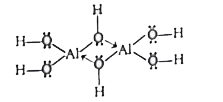Consider Al2(OH)6 compound and caculate the value of (X+Y)+Z Wher X=total number of (2c−2e−) bond.
Y=total number of (3c−2e−) bond.
Z=total numbe of (3c−4e−) bond
The correct Answer is:5
X=Total number of (2c−2e−) bond=10
Y=total number of (3c−2e−) bond=0
Z=total number of (3c−4e−) bond=2

(10+0)+2=5
Topper's Solved these Questions
- p-BLOCK ELEMENTSBOOK - VK JAISWALCHAPTER - p-BLOCK ELEMENTSEXERCISE - ASSERTION REASON TYPE QUESTIONS
27 Videos
- METALLURGYBOOK - VK JAISWALCHAPTER - METALLURGYEXERCISE - ASSERTION-REASON TYPE QUESTIONS
30 Videos
- PERIODIC PROPERTIESBOOK - VK JAISWALCHAPTER - PERIODIC PROPERTIESEXERCISE - ASSERTION-REASON TYPE QUESTIONS
35 Videos
Similar Questions
Consider Al2(OH)6 compound and calculate the vale of (X+Y):=Z
Where X= Total number of (2c−2e−) bond.
Where Y=Total number of (3c−2e−) bond.
Where Z= Total number of (3c−4d−) bond.
View SolutionConsider the structure of Al2Me6 compound and find the value of xy
Where, x= total number of atoms that are sp3 hydridised and y= total number of 3c2e bonds.
View SolutionConsider the structure of Al2Me6 compound and find the value of x−yz where x= maximum number of atoms that can lie in place having terminal (Al−Me) bonds
y= total number of 3c−2e− bonds
z= total number of atoms that are sp3 hydrized.
View SolutionConsider the structure of Al2Me6 compound and find the value of x−yz where x= maximum number of atoms that can lie in place having terminal (Al−Me) bonds
y= total number of 3c−2e− bonds
z= total number of atoms that are sp3 hydrized.
View SolutionConsider the structure of Al2Me6 compound and find the value of x−yz where x= maximum number of atoms that can lie in place having terminal (Al−Me) bonds
y= total number of 3c−2e− bonds
z= total number of atoms that are sp3 hydrized.
View SolutionTotal number of bonds in HC≡C−C≡CH ?
View SolutionTotal number of bonds in HC≡C−C≡CH ?
View SolutionConsider the following compounds
(1)H3CF (2)H2CF2 (3)CH4 (4)H3CCF3 (5)CH3CH2+ (6)C2H4
and calculate value of Y+X, (where X is the total number of compounds which have H−C−H bond angles equal to 109∘28' and Y is the total number of compounds which have H−C−H bond angles greater than 109∘28' and less than 120∘
View SolutionConsider the following compounds
(1)H3CF (2)H2CF2 (3)CH4 (4)H3CCF3 (5)CH3CH3 (6)C2H4
and calculate value of Y+X, (where X is the total number of compounds which have H−C−H bond angles equal to 109∘28' and Y is the total number of compounds which have H−C−H bond angles greater than 109∘28' and less than 120∘
View SolutionConsider the following compounds
(1)H3CF (2)H2CF2 (3)CH4 (4)H3CCF3 (5)CH3CH3 (6)C2H4
and calculate value of Y+X, (where X is the total number of compounds which have H−C−H bond angles equal to 109∘28' and Y is the total number of compounds which have H−C−H bond angles greater than 109∘28' and less than 120∘
View Solution
